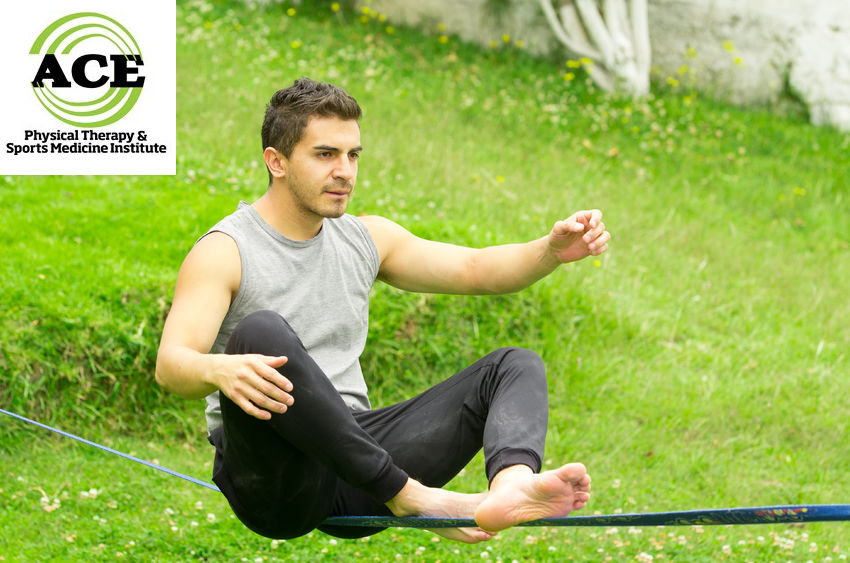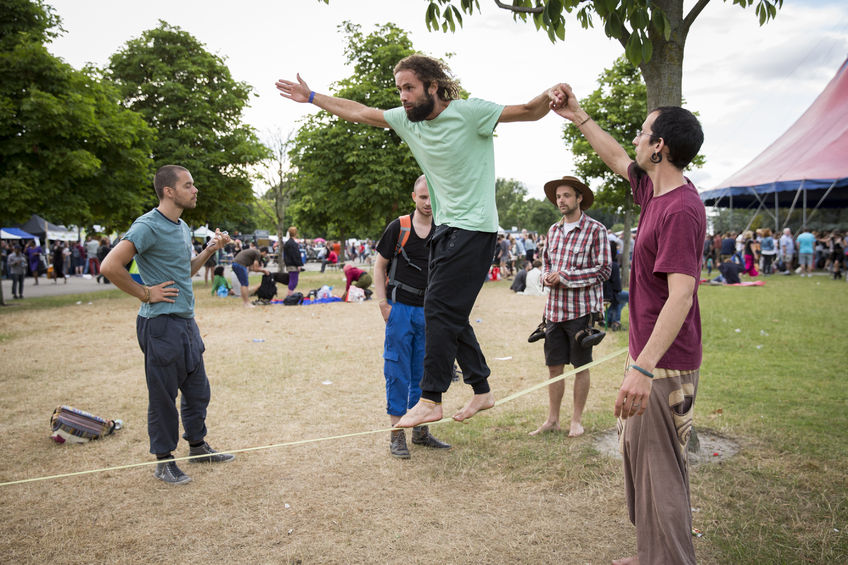SLACKLINING

Tid Bits of Info
- Slacklining was first started in the late 1970s.
- Slack lines are not taut like a tightrope and made of different materials.
- Slacklining can be performed by anyone of any age.
- Most slack lines are a couple of inches off the ground but can be hundreds of feet in the air.
- If your balance is not good, seek the advice and treatment of a Physical Therapist.
Slacklining brings the thrill of the circus into your backyard for health and fitness. What is slacklining? Basically, it is walking on a tensioned nylon strap. The strap is normally anchored between two trees. While it looks like tightrope walking, it’s not really the same thing because the strap is not taut. It is a sport, a hobby and as it turns an option for rehabilitation healthcare. Slacklining has been shown to help people improve their strength, balance, coordination, and concentration. By engaging all aspects of our equilibrium, it can help to train and develop our sense of balance.
Balance requires a great deal of neurological control and involvement. The eyes, vestibular system, kinesthesia, and proprioception all play a major role in helping someone stay balanced. The musculoskeletal system must be strong and healthy enough to remain is a given position for a period of time and be able to respond to a sudden change without falling down. Like most activities and skills, the human body can be “trained” to respond more efficiently and effectively to changes which helps a person maintain balance.
The human nervous system controls all motions one way or another. There are voluntary responses in which we “think” about a motion and then perform it, but there are involuntary or reflexive motions that must be under control to get the most efficient response from the body. These involuntary responses can be “trained” to improve one’s balance. In most instances, movement is a combination of voluntary and involuntary movements.
Slacklining has been likened to walking a tightrope, but there is one big difference. The slacklining rope is really a 2-inch nylon strap that is not taut like a tightrope. The slacklining band is looser and “gives” as someone walks across it. More than a tightrope, the “give” produces a slight bounce or unstable surface to walk across.

Training the nervous system to improve balance involves working out or performing exercises and activities on unstable surfaces. Healthcare providers try all types of surfaces to challenge their patient’s nervous systems and in turn help to “train” it to respond more efficiently. When the nervous system is “well- tuned” it is capable of controlling the voluntary and involuntary movements which increase the kinesthesia and proprioception of the different joints and body parts. The ability of the nervous system to control the position of the joints of the body leads to more efficient motions and better balance.
Physical Therapists include various treatment protocols that involve exercises on unstable surfaces. Slacklining has not been employed extensively in the Physical Therapy setting to date, but it is one more way to that can be used to challenge and “train” the nervous system. There is no restriction on the age groups that can benefit and in studies that have been done to tests its effectiveness the results are encouraging demonstrating an improvement in balance after as little as 4 weeks of slackening training. It has been reported that all age groups are challenged and have reported that they enjoyed their experience on the nylon strap.
Seeking the advice and treatment of a Physical Therapist is easy and does not require a visit to your doctor. Your insurance policy might require that you get a referral from your primary physician but you do not need a doctor’s prescription.
Slacklining is relatively new and is catching on in the healthcare world. It can be used to stimulate and train the nervous system and help to develop more strength, greater balance, coordination, and concentration.

























How many times have I seen patients who find normal exercises mundane and boring?!
As physical therapy students we have always been reminded to be “creative” with our therapeutic exercises and let our patients buy into our treatment and enjoy doing those exercises. Balance training is one of the areas that we could become creative and come up with the exercises that are both challenging and fun to perform. Slacklining or similar versions of balance training exercises are effective ways to address ankle strategy, especially in patients who have sustained ankle injuries, sprained ankle ligaments or had any proprioceptive damage to their ankles. This is an effective way to address ankle proprioception further down the road when patients do not have any range of motion deficit and are ready to be functionally trained,especially for athletes who look forward to get back to competitive level of activity.
I deeply enjoyed this article and how it broke down the systems needed in order to maintain balance. I have explained to many of my patients what makes balance and how we as PTs can retrain the balance systems if impaired. I also have had ankle sprain or fracture patients work on “tight rope” walking in the clinic to help with the somatosensory component of balance which is commonly hindered after an event such as an ankle sprain. Proprioceptive training is important with ankle sprain or ankle injury patients but can also be applied to those with diabetic neuropathy or any neurological disorder. I enjoyed the education and trying to make PT fun with these exercises and enjoy somewhat mimicking this activity at clinic just not with the slack rope.
Love this article! I hadn’t even heard of slacklining until our PT school orientation picnic. It was humbling for me but doable with assistance. Later in research classes I learned slacklining has been used for helping those with Parkinson’s experiencing freezing of gait and saw significant improvements. My nephew the climber uses it as a hang out tool with his brother who much prefers foot on the ground and they both enjoy the challenge. My daughter even now owns one. It is a great way to enjoy nature, camaraderie, build strength, and I think can become transformational.
This is such a fun article! It is so important to integrate activities that people love into their therapy plan. Slacklining is particularly nice because it’s challenging and easy to see improvement as you practice. I like that this article points out that slacklining is appropriate for any age; there are certainly some older adults that are in excellent shape and capable of participating in an exercise like this. However, it’s not for everyone. Given that this is difficult for people without any balance or vestibular impairments, it would definitely be a higher level task that would be built up to.